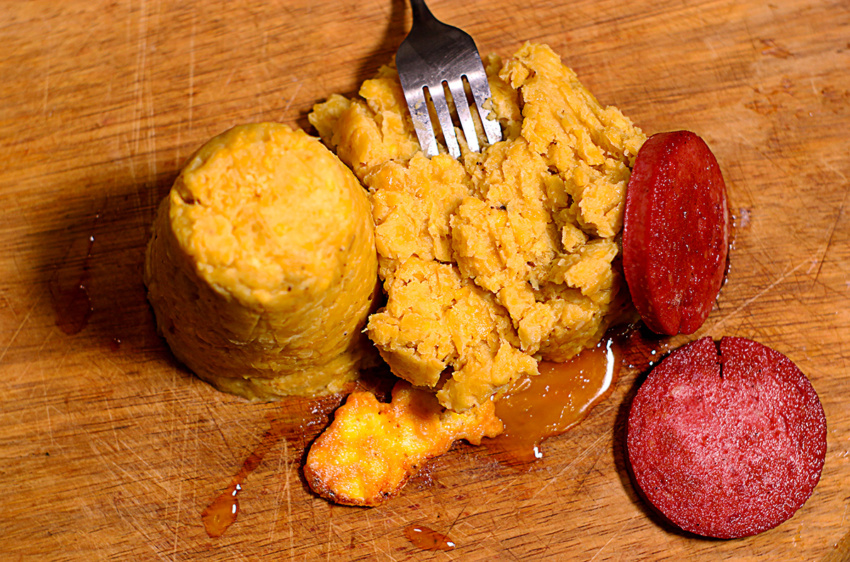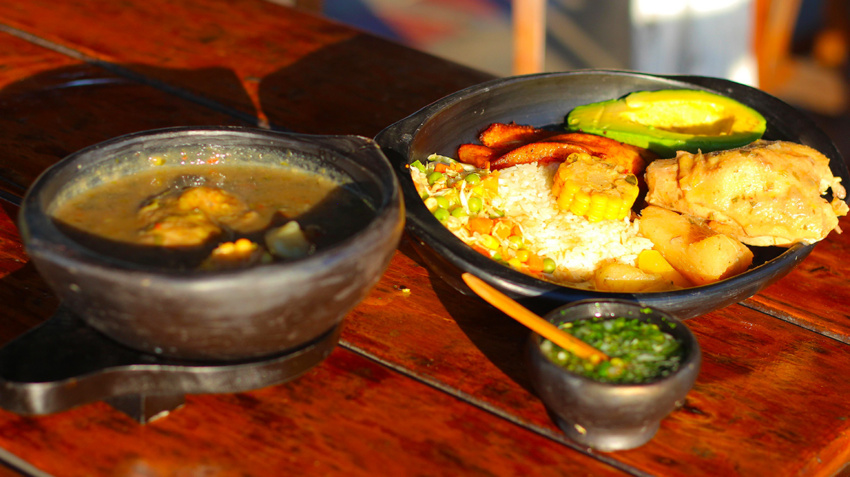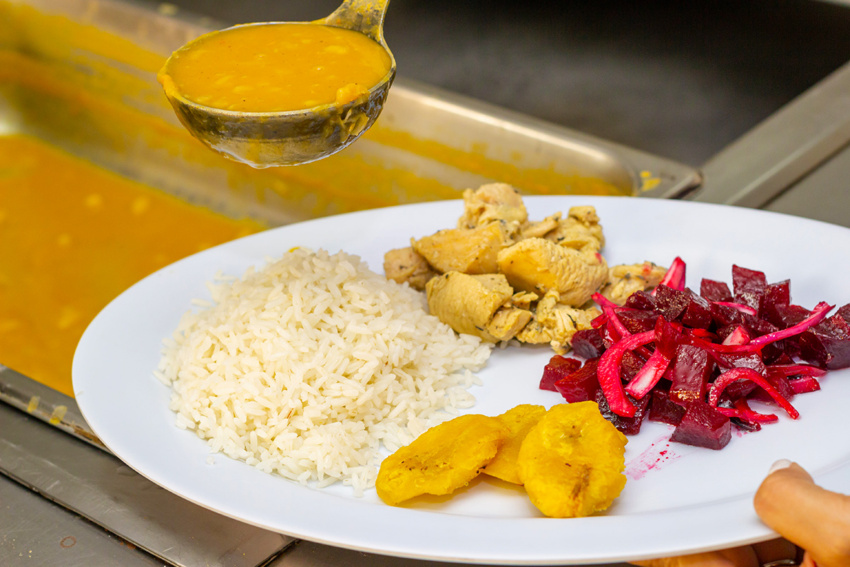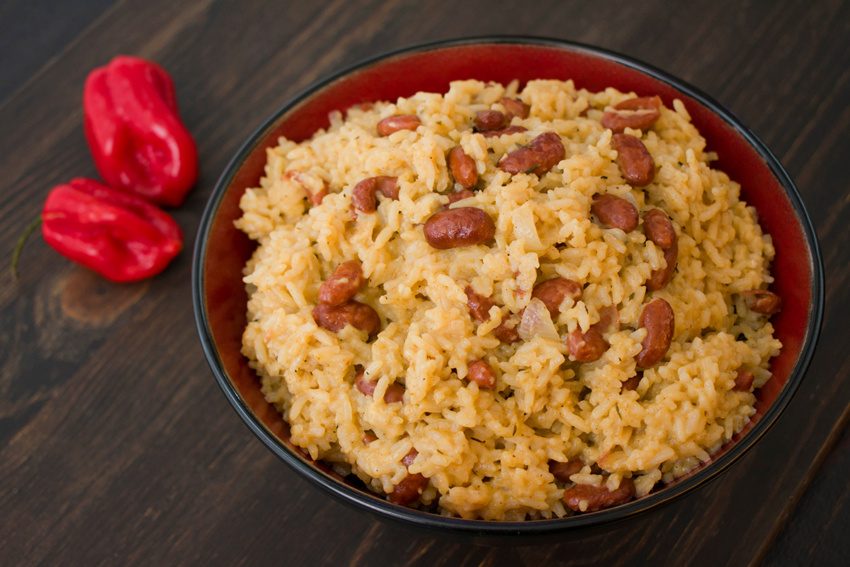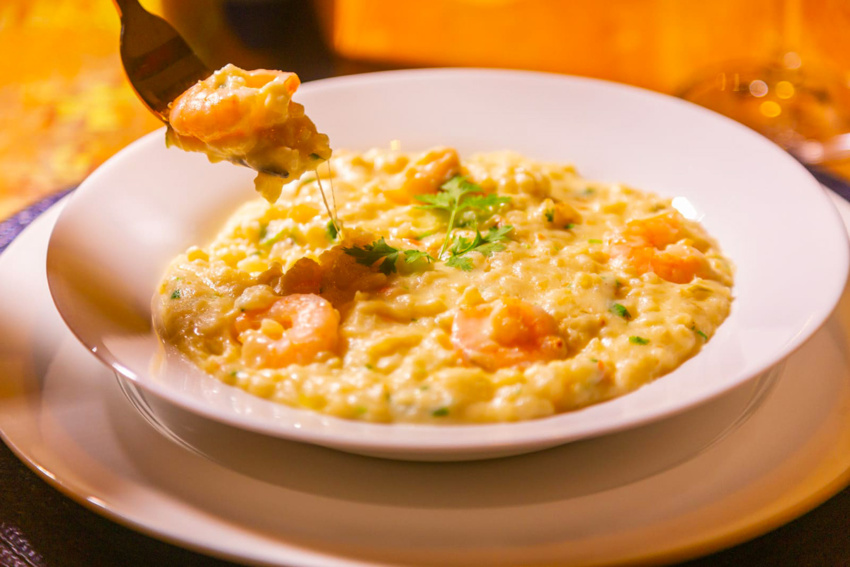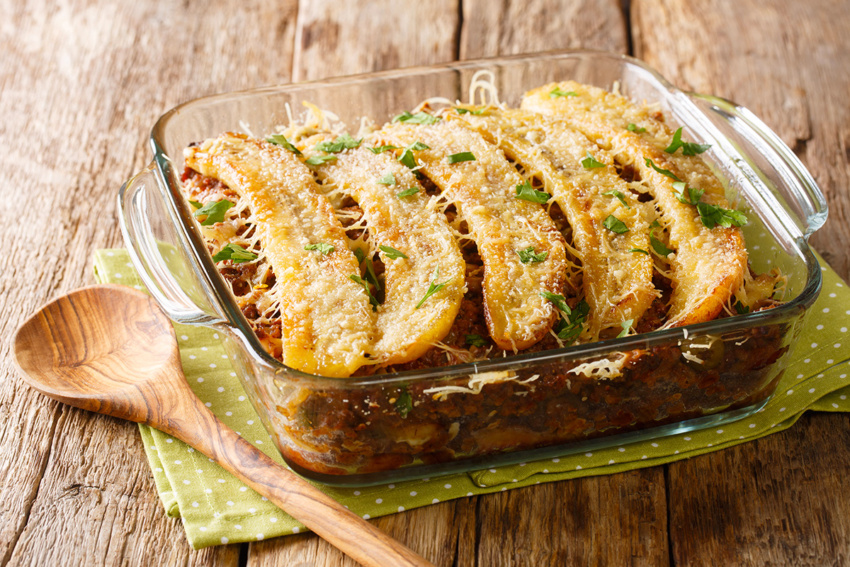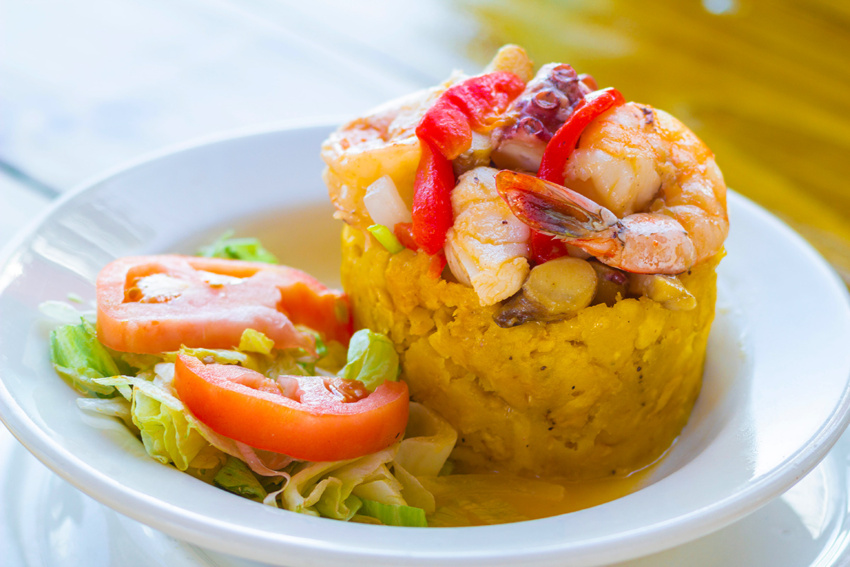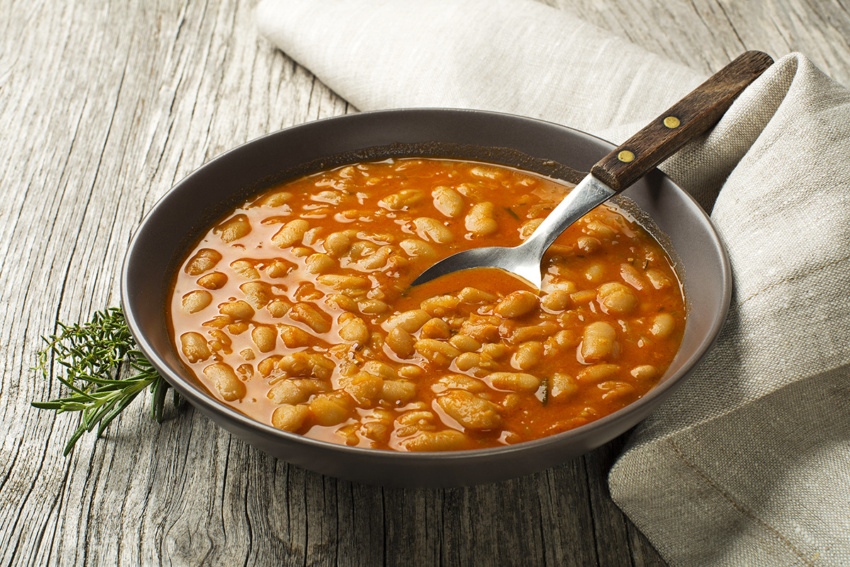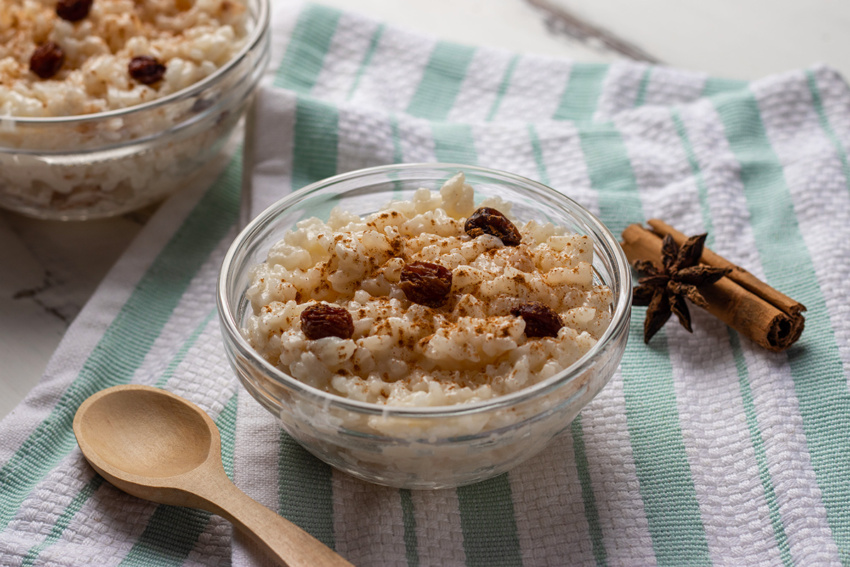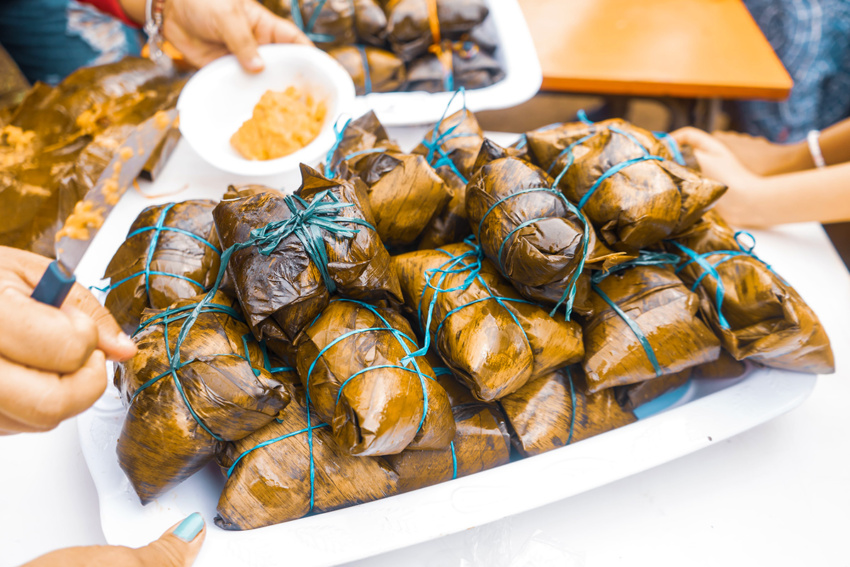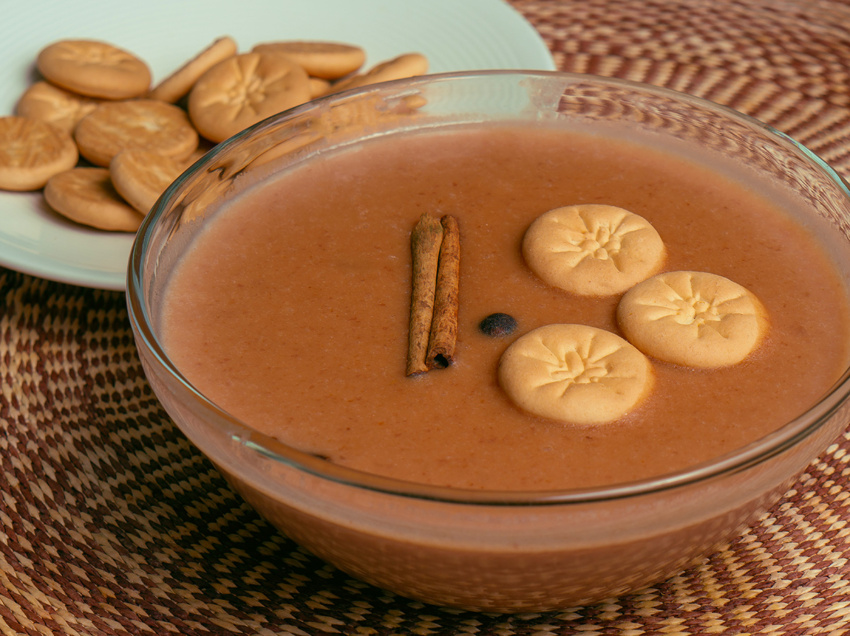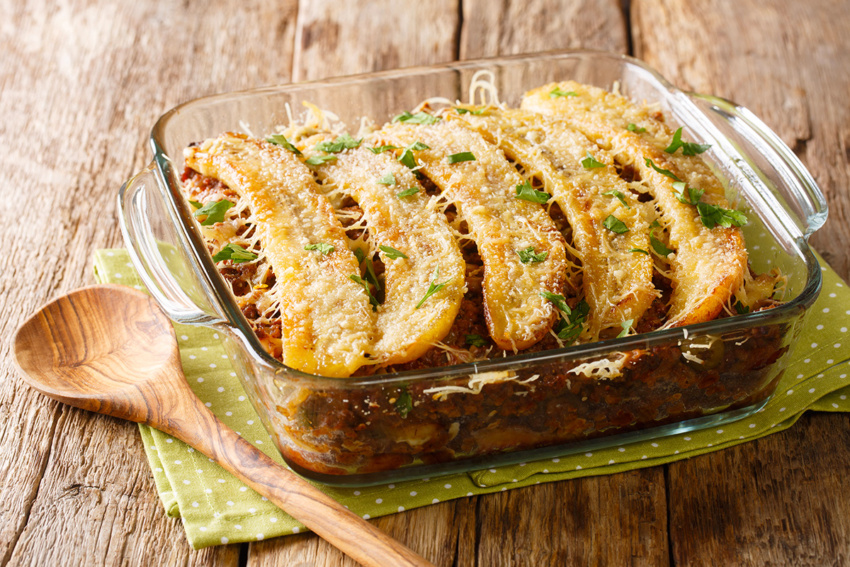
Dominican cuisine has been influenced by Lebanese, French, Italian, and Chinese cuisines. Under the influence of Spanish cuisine appeared a sancocho – one of the variations of cocido in Madrid, or asopao – a type of Spanish paella. Features of the cuisine of different countries deeply penetrated into the culinary traditions of the Dominicans. We have created for you a small list of national dishes of the Dominican Republic, and we strongly advise you to try them.
Top 11 Must-Eat Dominican Cuisine Dishes
El mangú
El mangú Dominican dish
The name of the dish is said to have appeared since the first United States invasion of the Dominican Republic (1916-1924). One of the American soldiers, who tasted the dish, said approvingly: “Man! Good!” For the Dominicans, it sounded like “Mangu”. This is how the name appeared.
Another version is that it comes from the Congolese word “mangusi”. The term is the word for “mashed banana”. In essence, it is very similar to recipes from other Latin American nations such as the Puerto Rican mofongo, the Ecuadorian bolón or the Cuban fufú. This is due to the presence of green plantain in the form of puree.
Mangu is one of the main dishes in the Dominican Republic. It is served on its own or as a side dish and is the most popular food among ordinary people. Mangu is grated boiled bananas picked while still green. Mangu is usually served with fried red onions.
Mangu is included in a typical Los Tres Golpes breakfast. For breakfast in the Dominican Republic, mangu is traditionally served with fried cheese, bacon or salami, omelette, or scrambled eggs. You can try such food in many restaurants of the resort. There is also a sweet version of this dish.
It is so important for local culture and tradition that there is even a date dedicated to its preparation. Since 2021, every second Sunday after January 26, the day on which the “Mes de la Patria” (“Month of the Fatherland”) festivities begin, the National Mangú Day is celebrated. Likewise, after multiple campaigns on social networks, the Royal Spanish Academy was able to include the term in its dictionary.
You can try el mangú at Kat’s Corner, Gabi Beach, Delicias de Bavaro, Dalia’s Cafe & Bakery.
Masterpiece sancocho
Sancocho dish
Looking back over the centuries, you will find that the most successful recipes have usually come a long way and gone through many changes before crystallizing into the perfect combination of flavors. So, it was with the sancocho. Having discovered the amazing lands of South America, European countries colonized them. There were territories subject to Spain and France.
The colonialists brought with them their traditions and customs, including culinary ones. The favorite dish of the Spaniards was puchero – meat and vegetable stew, the French preferred stew cooked according to a special recipe. Both of these options were later gradually combined into one dish, and the amazing sancocho soup was born.
Previously, sancocho was cooked in a huge cauldron, which was installed on hot coals, gradually adding all the necessary components. Stirring the soup in such conditions had to be done with a wooden shovel.
Traditionally, in Dominican cuisine sancocho is a soup made with seven different types of meat… yes, you read that right, SEVEN types of meat! However, today it is very rare for someone to do this with seven different kinds of meat.
Sancocho is a masterpiece of the culinary skills of Dominican chefs – several types of stew (beef, pork, chicken) with the addition of yuca, plantain, and vegetables. It is savory and spicy, and very satisfying. Sancocho options are incredible. And ordering it in different restaurants is like trying different dishes.
The constant ingredient of sancocho is young corn. The broth is cooked on meat or fish, then pork sausages, pieces of bacon, small fish, garlic and onions, all kinds of peppers are added (at the request of the cook). The dish is served in a deep bowl with an additional plate. Everything solid is eaten like a stew, sipping the broth separately.
You can try sancocho at Bohio Punta Cana, La Casita de Yeya, La Yola, Delicias de Bavaro.
La Bandera
La Bandera dish
The origin of this dish dates back to a dark period of Dominican history called “Meek Spain”, as a result of an economic crisis on the island and its deficiencies. The settlers had to eat what little they produced: beans, rice from their swampy areas, and meat from the cattle herds that abounded in the country.
The term ‘la bandera’ (eng. ‘flag’) refers to the colors of its national flag, each of them present on a plate with foods that represent the colors of that flag: blue, red, and white. White is represented by rice; red for beans, and blue for meat. La Bandera is also the very reflection of the multicultural and mestizo conformation of the Dominican people: Asian rice, South American beans, and European meat.
Usually, la bandera includes white rice, bean stew, meat (chicken, pork, or beef), and vegetable salad (tomatoes, cucumbers, lettuce, greens). These elements are the daily food of the vast majority of Dominicans (as constant as the daily raising of the flag).
Yuca tortillas, ripened or green sycamore (a type of banana) eaten both green and ripe fried in oil, corn tortillas, or eggplant fried in breadcrumbs can sometimes be added to this menu. If it is required, meat is replaced with stewed cod.
You can try la bandera at Bohio Punta Cana, Playa Blanca Restaurant, Pastrata Mexican Restaurant, La Casita de Yeya.
El Moro
El Moro – Typical dish of Dominican cuisine
Beans are known to be native to Latin America. In Spain, it is used to make moros y cristianos (eng. Moors and Christians): rice with beans and chorizo. Once back in Latin America, the dish was transformed under the sun of the tropics into gallo pinto (“speckled rooster”) in Central America; congri (a word that has no translation, but is clearly borrowed from one of the African slave languages) in Cuba, or moro – in the Dominican Republic.
In the role of the “Moors”, who never existed on the Caribbean island, except for the Spaniards themselves, in whose veins the blood of the Arab conquerors flows, the same black bean acts. It is cooked in a special way with rice, but the main feature is the addition of coconut milk. The rest is the same Cuban congri. Its consumption is related to special occasions, such as Christmas Eve. Likewise, the dish has its place in magical-religious rituals.
El Moro is another typical dish of Dominican cuisine made from rice that is mixed with beans or pigeon peas. It is delicious with any stewed or fried meat that you love. It is an excellent dish with an exquisite taste that can be enjoyed by any palate, without a doubt it will make your table an exotic destination that is fulfilled.
You can try el moro at TOC Beach Bar & Restaurant, Noah, La Casita de Yeya, La Yola.
El asopao
Asopao de mariscos – Dominican rice soup
An example of the creativity of Dominican cuisine is asopao, a dish that can be very particular depending on the imagination of the person who cooks it. The word asopao is a contraction of “asopado”, which means soupy, or soup-like in Spanish. In English, the translation for asopao can be “rice stew” or “rice pottage”.
This rice soup, which is prepared with different seasonings, is typical of the Caribbean, and one of the most important dishes in Dominican gastronomy.
This dish is one of the favorites for family gatherings and festivities, since many people eat with few ingredients. The soup is usually cooked with chicken or shrimp. Asopao in the Dominican Republic is usually cooked with beer, sofrito, bouillon cubes, olives, capers, plantain, and sour orange.
- Asopao de pollo (the chicken version) is usually served with plantain meatballs. Chicken asopao can also include beer, smoked ham, ham hock, corn on the cob with more smoked seasoned cumin, achiote, and coriander seeds.
- Asopao de mariscos – rice soup with seafood, spices, unsweetened bananas, onions, and herbs. Cooked from freshly caught shrimp, squid, and other seafood.
You can try asopao at Noah, La Yola, Playa Blanca Restaurant, La Casita de Yeya.
Pastelón de Plátano
Pastelón de Plátano
Plantains are the main ingredient in this Dominican dish. However, initially, they were not here at all, only in Asia. First, Alexander the Great brought them from India to Greece. Then these fruits gained more global distribution thanks to Arab sailors who planted them on the coast of East Africa. African slaves, on the other hand, had to find a use for bananas and plantains in the kitchen, where they were forced to work and live. Among those places was the Caribbean.
Such countries of these coasts like Colombia, Costa Rica, Cuba, Jamaica, Panama, the Dominican Republic, and Guatemala, for years were called as “banana republics”, mainly dependent on agricultural production almost reduced to bananas, sometimes governed by tyrannical, corrupt, and enriched governments at the expense of their inhabitants, and politically influenced by large US firms, owners of the land producing the fruit.
Although for decades the political and violent history of several of those countries revolved around crops, the generations that suffered it learned that if life gave them bananas, they had to learn to eat them.
And the taste grew for fresh plantains, as well as tostones, slices, patacón pisa’o, stuffed plantain, patacón with everything, plantain cakes, plantain soup… They even managed to use the banana leaf on the grill, as a plate, to bake food, and to wrap tamales, milk curds, and guava sandwiches. This is how pastelón de plátano was born.
Meat pie with bananas (pastelón de plátano) – sounds rather unusual for other cultures but not for Dominican cuisine. Bananas in this dish are used instead of the traditional dough. They are kneaded and laid out in a thick layer in a form, minced meat is placed on top, flavored with onions, spices, and herbs (optional), and then another layer of bananas is placed. Then the cake is sprinkled with grated cheese and put in the oven to bake. In some parts of the Dominican Republic, as well as restaurants and cafes, wine, nutmeg, raisins, and even eggplants are also added.
The popularity of the pastelón is due to the fact that it perfectly combines sweet and savory flavors and you can adapt it however you want: add your favorite cheese, opt for chicken or beef or add any other ingredient you like. It can be used as a main dish, accompanied by a salad. You can also have it as a side dish.
You can try pastelón de plátano at Montes Quick Shop.
El mofongo
El mofongo – a hallmark of Dominican cousine
The mofongo has become a hallmark of Puerto Rican and Dominican gastronomy. And although it is said that this dish is original to Puerto Rico, most research indicates that it was introduced by African slaves to the Caribbean, during colonial times, when the slaves’ diet consisted mainly of the traditional green plantain accompanied by meat they could find. This is confirmed by the existence of a very similar African dish, called fufu, typical of Ghanaian cuisine.
That combination of fried plantain with pork rinds and aromatic garlic is fabulous, which is why it has become a mandatory reference in Caribbean cuisine. And in addition to finding it in its original version, other versions where the ingredients are replaced by similar ones are already becoming just as popular.
Today there are varieties for all palates: beef, shrimp, cassava-based, and even for vegetarians. It is served alone or accompanied with chicken broth. Also with beef broth or with a little broth so as not to eat it dry.
You can try el mofongo at La Casita de Yeya, Delicias de Bavaro, Noah, La Palapa de Eden Roc.
Las habichuelas guisadas
Habichuelas Guisadas Dominican dish
Habichuelas Guisadas (stew beans) is a Dominican dish that can be found on almost any Dominican table. Dominican stewed beans are a mix between soup and sauce. The beans must have some “cream”, or very creamy “sauce” since it is used to “wet” the rice or the concón, if you are lucky enough to get a little. The beans should never resemble Mexican refried beans, for example, nor should they be so watery that they resemble soup.
Dominican-style stewed beans are one of the greatest culinary secrets of modern cuisine. Those who have tried them are captivated and marked for life. What appears to be a simple recipe is actually a test for the masters of Dominican cuisine. It is a dish of experts and the mark of the master of Dominican cuisine.
Dominican stewed beans combine techniques, ingredients, colors, and flavors that testify to the origin of the Dominican culture itself: Taino-African-European miscegenation culture, with bright and vibrant colors; of pure and clean flavors despite the cooking process with the care of the grandmothers and the love of boho.
Beans are a cheap but high-quality source of vegetable protein. It is one of the most common ingredients in Latin America, and in the Dominican Republic, moreover, it is part of the “la bandera” (“Dominican Flag”).
You can try las habichuelas guisadas at Gabi Beach, La Casita de Yeya.
El arroz con leche
El arroz con leche – a traditional Dominican dish
Rice pudding (el arroz con leche) is a traditional dish of Dominican cuisine, characterized by its simple preparation and cheap ingredients: rice, milk, sugar, and sweet spices. The countries where this dish is most consumed are, in addition to the Dominican Republic, Argentina, Bolivia, Uruguay, Honduras, Guatemala, and Spain.
Certainly, this is an almost universal dish, and it is found all over the world under various names and versions. In Denmark, it is known as Risalamande. It is made with cream instead of milk and served as part of the Christmas dinner. As a general rule, it is consumed, mainly, as a “small snack” made by the grandmother, however, it could also be an alternative for dinner.
Rice pudding appeared for the first time in Spain. Pasteurizadora Rica reflects the voice of gastronomic historians: in the Motherland a dessert called “menjar blanc” or white manjar was offered, mainly in the area of Catalonia and Valencia. It was made with almonds, chicken breasts, rice, and sugar. The complexity and list of ingredients meant it was only served in upper-class homes, and as a cheaper alternative some ingenious cooks created the rice pudding in the 17th century.
In its beginnings, the dessert was cooked with honey, which was the most widely used sweetener in Spain until cane sugar arrived from the eastern Mediterranean. In the country, rice pudding is eaten sweet or with salt. This will depend on the taste of who cooks it and each one has its particularity. In Dominican cuisine, for example, in addition to the basic ingredients, lemon peel, raisins, and even condensed milk are added.
Classified as sweet, rice pudding is a very nutritious dessert. It provides a high amount of carbohydrates, protein, and calcium, but also fats, so people with weight or cholesterol problems can replace it with skim milk or even soy milk.
You can try el arroz con leche at Los Gallos, La Yola, Hard Rock Cafe.
El guanimo
El guanimo – one of the oldest Dominican dishes
Guanimo or guanime is a Taíno word that designates an arepita made of corn that is wrapped in corn or banana leaves and put on the fire for a minute. Guanimos are wrapped in corn husks and tied tightly to prevent water from entering them when boiled, which produces their peculiar shape and markings when untied. Like the sheet cake, this dish is usually served with ketchup and hot sauce.
Guanimo probably originates from the northwestern provinces of the Dominican Republic, since the only people who seem to know this dish as such are from Montecristi. Both in Puerto Rico and in Cuba there are dishes with the same name (although with important differences).
This suggests that this dish predates the separation of the islands as single countries and these dishes could have a common ancestor, possibly Taíno. If this is so, then guanimo could be one of the oldest dishes of Dominican cuisine.
You can try el guanimo at La Casita de Yeya, Gabi Beach.
Las habichuelas con dulce
Las habichuelas con dulce – an exclusive dish of the DR
Sweet beans (las habichuelas con dulce) are an exclusive dish of the Dominican Republic, which is not consumed even in the countries closest to the island such as Cuba, Puerto Rico, and Jamaica. The ingredients (red beans, sugar, coconut and cow’s milk, sweet potato, and various spices) and the way of preparing sweet beans are a mixture of products and customs from different continents: America, Europe, Africa, and Asia.
The emergence of this dish in Dominican cuisine was influenced by the era of France in Santo Domingo in 1795-1809. There was a synthesis of the traditions of the two countries, the ingredients used, and as a result, habichuelas con dulce was created after the Independence in 1844. The French beans grown here and the imported ones had to be replaced by the beans that were in America since pre-Columbian times. Dominicans accepted French customs and began to consume French or Creole beans, sweetened or salty.
This dish of Dominican culture has evolved with social and technological changes. Before refrigeration systems appeared, they were consumed in a single day, hot, with whole grains and pure cow’s milk; while modernity allows its refrigeration and conservation, and facilitates its preparation by being able to liquefy the ingredients, as well as adding processed coconut and cow’s milk. Its flavor is so ingrained in the taste of Dominicans that it is currently sold canned, and even offers its flavor to a locally made ice cream.
The fact that it is not a dessert in itself, nor a dish that accompanies another, but rather the main course prepared for a special occasion such as Easter, makes it even more unique. In several countries, they mix beans and sugar in fundamentally salty foods, but they never make the mixture that characterizes the Dominican sweet beans. In Puerto Rico, Haiti, the U.S., and Spain it is possible to find the dish, but it is due to the presence of Dominicans or their influence.
You can try las habichuelas con dulce at Gabi Beach.
As a conclusion
- As an agrarian island nation located in a favorable climate zone, the Dominican Republic offers a variety of dishes with a wide range of ingredients, and the influence of the traditions of the Taino Indians, European and African culture in gastronomy adds a great palette of tastes with many shades.
- Locals take great pride in their Dominican cuisine and traditions. And they are not in a hurry to let something new and exotic for them into their lives. The exception is Italian cuisine and fast food. Dominicans are incredibly fond of Italian pizza, but they do not cook it at home, preferring to buy it in cafes and restaurants.

